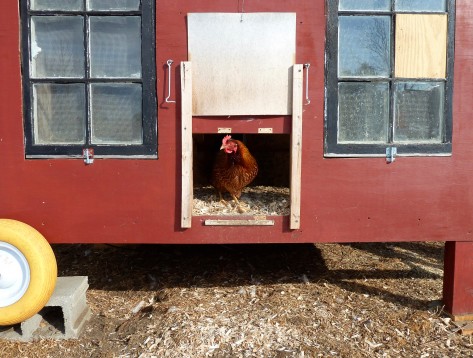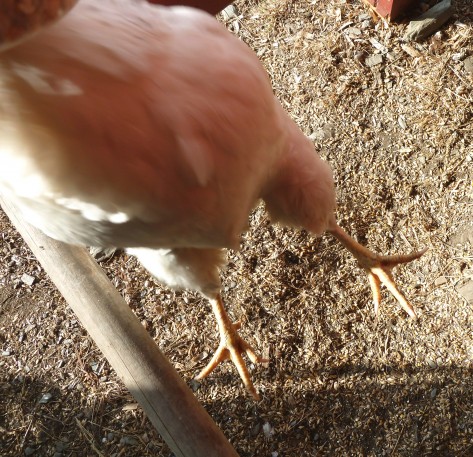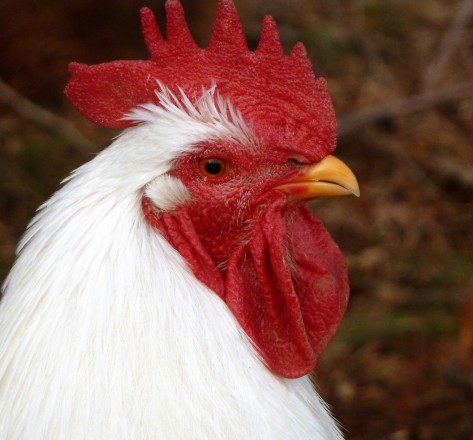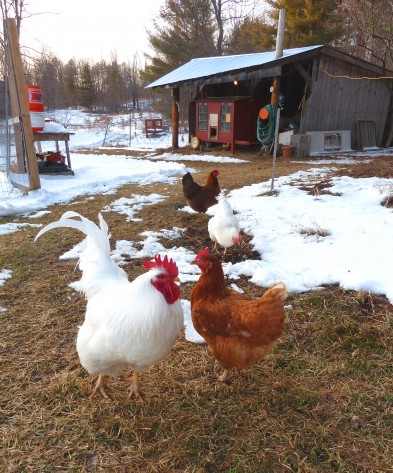Thai-Style Eggs, and the Hens That Laid Them

The Eggs:
One of the plates of eggs shown above is for Jack Sprat, the other, for his wife. Both preparations—deep-fried eggs and steamed eggs—are found David Thompson’s Thai Cooking, the current DCCC pick, where they are presented more as method than recipe.
The process of making deep-fried and steamed eggs was an interesting novelty; the process of eating Mrs. Sprat’s clear choice opened a door in my egg-eating life. Deep-fried eggs represent a distinct category in the pantheon of egg preparations—scrambled, fried, poached, soft-boiled, and so on. Which means there’s nothing else like it—except that the delicate border of crunchy whites may bring tempura to mind.
Hard-cooking eggs via steam creates very tender eggs—no rubbery white here—though the control is less exact than when boiling them (you can measure the temperature of water, but not steam). The gentle, even heat of steam cooking is similar to the egg cooking technique of Momofuku’s David Chang, chef, restaurateur, and cookbook author, in so far as the egg doesn’t sit directly on the bottom of a pot, where the heat would be greatest. (When cooking eggs for his celebrated ramen, Chang does submerge the egg completely in water, put places something on the bottom of the pot—a cake rack or steamer rack, for example—to keep the egg from touching the bottom of the pot and cooks the egg for a long time at a low temperature [40 to 45 minutes/140–145°F].) Besides getting an ultratender hard-cooked egg, there’s one more significant advantage to using the steaming method: It allows you to hard-cook a fresh egg and peel it with relative ease. If you’ve ever had difficulty peeling a hard-cooked egg, and didn’t know why, it’s because the egg was too fresh. If you spontaneously decide you want to make deviled eggs but only have fresh eggs in the fridge, there’s a solution. Steaming to the rescue!
Deep-Fried Eggs
(Adapted from a recipe in Thai Food by David Thompson)
Pour about 2 inches of canola or peanut oil (or other high heat oil) into a medium-size saucepan. (For safety, the oil should come up no more than about one-third up the sides of the pan; pick a pan size accordingly). Heat to 350°F. Break a large egg into a small bowl, then carefully slide it into the hot oil. Fry for 30 seconds, until lightly browned, turn, and cook for another 30 seconds. Remove with a slotted spoon and drain on paper towels. Eat while hot. You may cook two eggs at once, but no more.
David Thompson’s favorite way to eat deep-fried eggs is with a drizzle of sweetened fish sauce. I tried his suggestion using a 50:50 ratio of fish sauce and light brown sugar (palm sugar would be more authentic), which seemed about right, and ate the sweetened-fish-sauce-drizzled eggs on a bed of steaming hot Jasmine rice. Once through the crunchy exterior, you hit gold: warm, runny yolk in the center. Fast food fit for a queen.
Steamed Eggs
(Adapted from a recipe in Thai Food by David Thompson)
Steam as many eggs as you like, or that will comfortably fit in your steamer without crowding. Bring the water to a boil, then reduce the heat to medium to keep the water at a rapid simmer, and add the eggs. For yolks that are just set and still quite moist, like the ones shown in the photo above, steam large eggs for eight-and-a-half or nine minutes, then plunge into ice water to stop the cooking and, when cool enough to handle, peel, and season with plain or flavored sea salt. I suggest doing a test egg (since “medium heat” is not the same on everyone’s stovetop), and sticking with the same level of heat so that you can find the timing for the level of doneness you like, and consistently repeat it. I seasoned the steamed eggs with homemade celery salt: To make, toast 1 part celery seeds in a dry pan and crush with 6 parts sea salt. (This ratio and method for making celery salt comes from The Flavor Thesaurus by Niki Segnit.)
The Hens and their Rooster:
Here is our current flock, from the foreground, moving counterclockwise: Bob the Enlightened Rooster, a White Plymouth Rock; followed by Bossy Anita, a Rhode Island Red; then Sweetie Della, a Delaware; and Skittish Kate, a Wellsummer. In the background, you can see their coop, a moveable structure painted red to match the trim on our house with yellow wheels that don’t match anything and recycled windows with the original black paint. This photograph, taken one month ago, shows the coop in its winter location, tucked into the three-sided out-building that offers protection from wind with the windows facing south.

A closer view of the coop, with Kate about to head out for the day. Handsome Kate, tentative by nature, unlike her namesake Katherine Hepburn, is always the last one to leave the coop. My presence opposite the coop’s egress slowed her even more.

This photo of Della captures her personality: She is friendly and curious. You can see how close she is to my foot. Many chickens would be too skittish to voluntarily come so close. Not Della. As soon as I come anywhere close to the chickens’ whereabouts, she comes running over. I like to think that is coming to say hello, but probably she’s just looking for treats: chopped up cheese rind, stale bread, an old cucumber cut in half lengthwise.

Did I mention that Della likes her treats, and isn’t bashful? Here I was holding a plastic bag with treats in one hand and had the camera in the other. I knew she would crane her neck upward to look at the treat, as she always does, and I was hoping to catch her gaze in pixels. But while I was fiddling with the camera, she grew impatient and jumped excitedly toward her treat. You can see her feet are clear off the ground. Goofball is her alias.

When I told my friend, Mariah, a Buddhist, about Bob’s generous behavior, finding food for the hens and always allowing them to eat first, even letting Anita the bossy hen snatch food from him, she said he is enlightened. Thereafter, he’s been known as “Bob the Enlightened Rooster.”

Philip the Arab, Roman Emperor from 244 to 249
This photo of Bob shows, I think, his gentle, if not pondering, nature. Like some of the nuanced portrayals in stone of Late-Roman-Empire emperors, whose frown-burrowed foreheads catalog the turmoil of the time—internal conflicts within and threats from encroaching Barbarians from without—Bob looks a little uncertain of his role as protector and peace-maker, as though, if he had to do it all over again, he wouldn’t choose his life of managing and defending a flock of nit-picking, hen-pecking females.


The deep fried eggs are great, though I’m struggling to get the oil temperature right. Love the fish sauce with them – added some red pepper flakes and finely chopped shallot to the fish sauce and palm sugar mix on the stove. Yum.
1I didn’t have the temperature hot enough, myself, the first I made the fried eggs. So they just took a bit longer to cook. What kind of trouble are you having with the heat? Did you use the recipe for Sweet Fish Sauce on p. 482 of THAI FOOD as the inspiration for your sweetened fish sauce? You’re a better woman than me! I lazed out and just sweetened the fish sauce with sugar; I bet it’s very nice with shallot and a bit of fiery pepper.
2